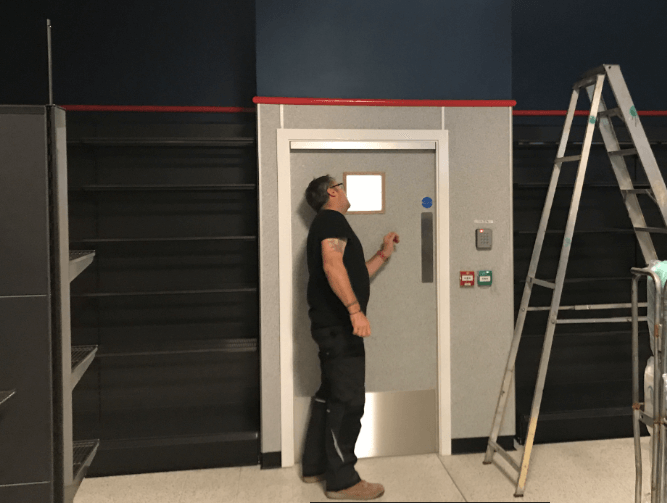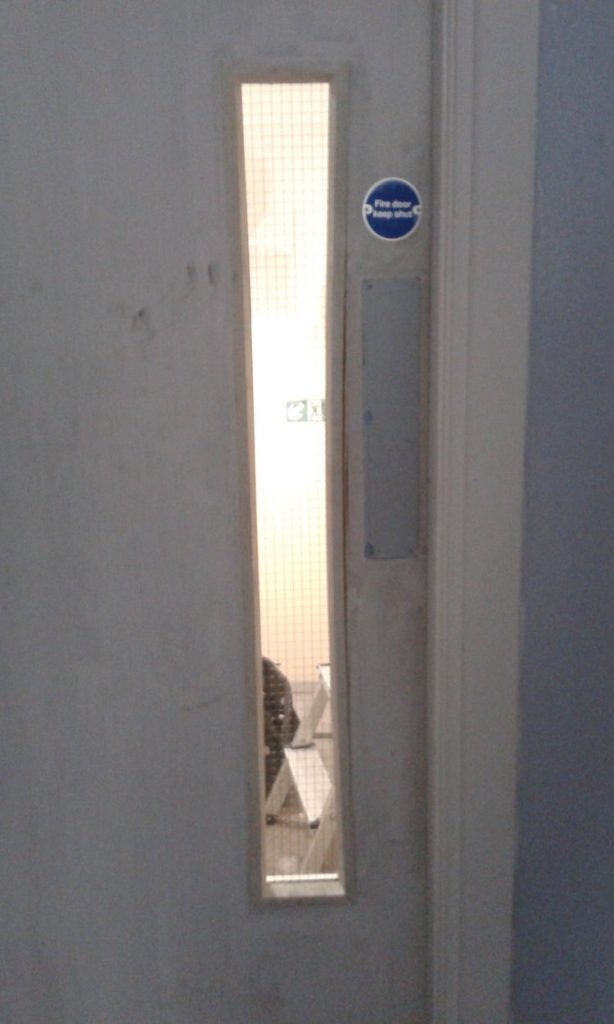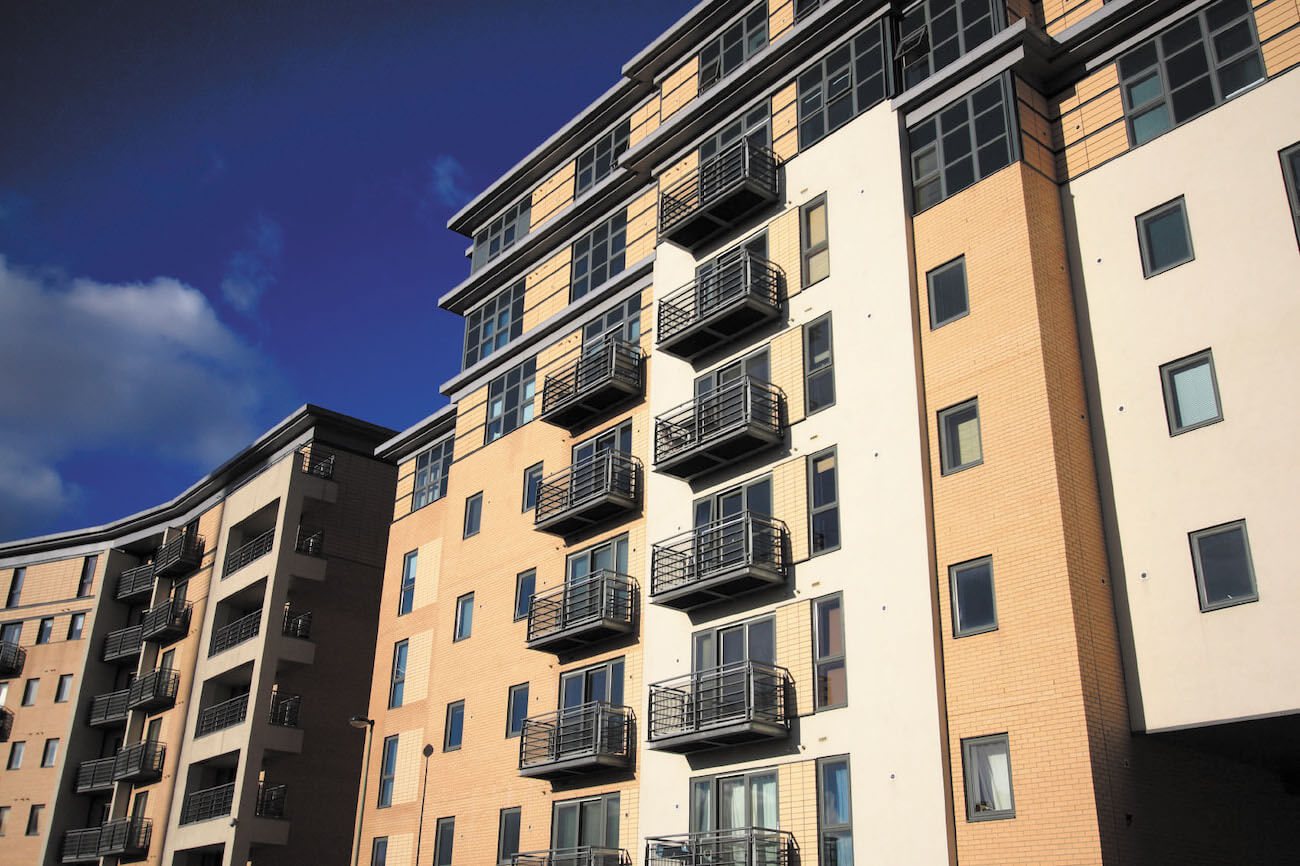
Just like many other products fire doors can be purchased at various levels of price and quality. The end use of the door will dictate the type of door and type of hardware you buy and install, also doors can be made from timber, metal and composite materials so let’s look at some common end uses as a guide.
Flat entrance doors
There are two ways to procure fire doors: the fire door assembly and the fire door set. The fire door set is particularly suited to flat entrance door applications.
All new fire doors must have evidence of fire performance and based on that evidence the door leaf or door-set manufacturer will be able to provide a product data-sheet or product manual that provides instructions for installation and details about requirements for essential hardware and seals. This is especially important for fire door assemblies because a fire door assembly is a collection of components obtained and assembled by the installer to meet the required performance requirements. Component compatibility and correct installation is critical to performance so installation instructions must be strictly adhered to.
A fire door set is of course also a collection of components, all doors are a combination of leaf, frame and hardware but the important thing about a fire door set is that the supplier/manufacturer undertakes to supply all essential components as a ‘set’ and takes responsibility for component compatibility. In effect, there is an implied warranty that all components when correctly installed will perform to meet the door set’s design performance requirements.
A fire door set can be purchased ready-assembled with nearly all components fitted at the factory and ready for installation into the door opening or it can be purchased part assembled or as a set of loose components, the important point being that sold ‘as a set’ all components are matched for compatibility and suitability by the supplier/manufacturer.
The door set is the ideal choice for flat entrance doors. A flat entrance door will in the vast majority of situations need to be an FD30s-rated door but will also likely be required to comply with security standards too. Therefore when purchasing a door-set to the necessary specification standards the buyer can comply with regulations without having the responsibility of ensuring each particular component is compatible, because the door-set supplier/manufacturer undertakes to do this.
Most flat entrance doors will be single leaf and single action doors and so may be purchased almost completely assembled so that the installer can fit the almost-complete set to the opening and then install and adjust the remaining components: self-closing device and fire/smoke seals for example. The installer must be diligent in their strict adherence to the manufacturers’ installation instructions including ensuring that the door leaf self-closes completely into the door frame from all opening angles, that the correct number, type and size of fixings are used to secure the door-set to its supporting wall, that the surrounding wall construction is suitable and that fire-stopping is completed correctly.
Fire door installation is not an easy task but by procuring a fire door set the task can be made less difficult so long as the installer has the necessary instructions, access to the relevant standards and sufficient time to complete the work. There are various types of door sets available including timber-based and composite constructions. The procurement process should ensure the selection of the most suitable construction type and product for the end users taking regulatory requirements and standards into consideration. This may include fire performance, smoke performance, acoustic performance, thermal performance and security performance as well as durability and ease of installation. As with all types of work, proper preparation is essential so the survey work will be a key element and (apologies for the repetition but) by engaging a certificated fire door inspector (CertFDI) the building owner/operator can more reliably procure the most suitable door-set and ensure via inspector/installer liaison before, during and after installation that the door-set is correctly installed so as to comply with fire safety and other requirements. Importantly, competent inspection will also ensure that the door set’s durability qualities are not compromised by incorrect installation work.
Doors in communal areas, cross-corridor and stair lobbies
This group of doors includes blocks of flats, hospitals, care facilities, busy offices and public buildings. The doors will need to provide fire and smoke separation but will also be subject to a high level of wear and tear and possibly some abuse.
As with flat entrance doors by specifying a fire door-set rather than a fire door assembly the task of component selection is undertaken by the supplier/manufacturer. Another benefit of the door-set for these door types is that they often need to be pairs of doors (sometimes called double doors) and not all fire door leaves are suitable for double leaf use. The fire door-set supplier/manufacturer undertakes to ensure the door leaves are suitable for their configuration. For these types of doors besides the fire performance rating, which for hospitals and care facilities is likely to be FD60s rather than the FD30s at blocks of flats and offices, durability will be a key factor.
Core construction of timber based doors will be a key element to help ensure longevity so a completely solid core construction should be specified. Some fire doors have a tubecore construction that reduces the weight of the door but lacks the inherent strength of a completely solid core door. Another consideration is the section of timber framing that forms the stiles and rails around the perimeter of the core. Larger framing sections will offer better long term performance than small framing sections, or as is the case with many chipboard core doors no framing at all but just hardwood lipped edges fixed directly to the chipboard core.
The benefit of adequately sized timber framing around the core is that security of fixings to hardware such as self-closing devices and hinges can be improved therefore helping to prolong the life of the doors. This type of door will most likely require a glazed vision panel to assist in safe movement around the building. Glazed panels, even when fire rated, can be a potential weakness and here solid core construction has another advantage in terms of durability and resistance to impact damage over tubecore door constructions. Vision panels necessitate removal of a large part of the timber material and replacement with glass therefore potentially weakening the door construction and reducing durability. Consideration should be given to vision panel sizes and the size of the remaining margin of core construction between the glazed panel and the edges of the door leaf. Glazed timber-based doors with narrow glazing aperture to door edge margins will be inherently weaker and so the margins should be as large as visibility requirements allow.
Where impact damage is likely, consideration should be given to installation of impact protection to the faces and edges of the door leaves. This type of protection can be much more easily incorporated during door manufacture than being fitted as remedial works and together with a suitable core construction and vision panel size will make a huge difference to longevity. Similarly the door frame material should be of a sufficient sectional size and density to meet durability and fire performance requirements. Where the door frames are timber-based solid hardwood, and to a lesser degree softwood will very likely out-perform MDF door frames in terms of durability and where necessary impact protection can be fitted to the door frame as well as the door leaf. Metal door frames may be used in conjunction with some timber-based door leaves and the door manufacturer will be able to advise on compatibility from a fire performance perspective.
These days the meeting edges of timber-based double doors tend to be square rather than rebated and the durability benefits here are fairly obvious as in order for them to be rebated the door leaf thickness must be reduced by 50% at the doors’ most vulnerable point. Where a rebate is necessary consideration should be given to installation of an astragal instead. This will of course necessitate the use of a door-coordinator and this adds to the list of maintenance requirements.
Door hardware selection is key to durability because items such as hinges and self-closers are moving parts that rely on good design and quality of materials as well as the security of their fixing to the door leaves and door frame. These items of door hardware are tested for durability as well as fire performance and so the procurement process should ensure that selection is based on both fire and durability performance and not price alone.
Door handles should be robust enough for the end use of the door and back to back through fixings will be more durable than fixing to the door leaf face using short screws. However, intumescent gaskets may be necessary to help protect the timber core construction from charring at the bolt through point in a fire.
Where impact damage is likely then consideration should be given to installation of door controls such as electromagnetic hold-open devices linked to the fire alarm. Such devices must, when the alarm sounds, release the door from the open position so that the self-closing device can operate to close the doors. However, correct specification and diligent installation are very important because without sufficient care or consideration the door leaves can become distorted by the magnet acting against the self-closer to hold the door
leaf out of its natural plane. Free swing door-closers provide an alternative method to hold open requirements and are a type of door closer that can be used to improve fire safety. They can be specified and installed as a means of easing access and in buildings where heavy traffic is likely such as offices, schools, and healthcare facilities. They can be installed at the top of a fire door, allowing the door to swing freely with little force required to open it, or to be held open in any position. The self-closer will close the fire door automatically when the alarm sounds and can be hard-wired to the alarm system, or battery-operated and wireless. Hold-open devices must be safety tested weekly together with the fire alarm to ensure the doors release and close correctly, we would not advise their use in blocks of flats.
Fire doors to offices, cupboards, factories and warehouses
These types of fire doors may be less complex than the types we have considered above but, when specifying and installing, their consideration should be given to the end user in terms of traffic, use and abuse.
Where traffic is light, at an office, for example, a tube core construction fire door may be suitable and some can be fitted with glazed vision panels if necessary. Where this is a requirement check with the door manufacturer for suitability and be aware that vision panels must be installed by the door manufacturer or certificated processors, otherwise fire performance third-party certification will be void. Poorly installed vision panels will not provide adequate fire and smoke separation and could put lives in danger in a fire situation.

Poorly installed glazed vision panels will not provide fire and smoke separation performance and could put lives in danger. This one is a third-party certificated tube-core fire door but the vision panel has been so poorly installed as to have a severe effect on its fire separation performance.
Doors to locked cupboards may need to be fire doors due to the storage of flammable substances. They spend most of their life locked so durability may not be such an issue and this type of door will not require a self-closing device, subject to the requirements of local building regulations. However, the same levels of diligence as for other fire doors will be required during the installation work to ensure they provide fire and smoke separation performance to meet their design criteria. Installers should ensure suitable fire-rated locks are fitted and that installation does not compromise the fire performance of the doors.
Doors to factories and warehouses will need to be assessed in accordance with their end use and in some instances, durability may such a high priority that metal fire doors could be the most effective option. Metal fire doors can be fitted with vision panels but this work must be done by the original manufacturer.
In the workplace, especially in heavy industry, fire doors will present an obstacle to employees moving around the workplace and as work will be foremost in their minds, fire and smoke separation may be far from their thoughts. Consideration should be given to the installation of hold-open devices as described above in the section about cross-corridor doors.
Inspections, maintenance and remedial works
Of course, all fire-resisting doors will require ongoing inspection and maintenance so whether new doors have been installed or whether the existing fire doors are retained, regular inspections will be necessary. So that brings us back to part one where we advised that the fire risk assessment should be reviewed periodically to ascertain which doors at the building need to be fire doors.
Inspections should be carried out as necessary and periodically in accordance with the use of the doors and how critical their performance is to the fire strategy at the building. Guidance is available in BS 9999 Fire safety in the design, management and use of buildings Code of practice, BS 9991 Fire Safety in the design, management and use of residential buildings Code of practice and BS 8214 Timber-based fire door assemblies Code of practice.
Some regular inspections such as door release systems should be checked weekly in-house but competent fire door inspectors should be engaged as necessary to provide an expert inspection and detailed report on the fire and smoke performance of the doors. The inspector’s report will assist the building owner/operator in maintaining the doors as fit for purpose. The inspection report will detail any defects and describe what needs to be done to rectify them. The inspector can also provide details about what can be done to protect doors from damage and prolong the service life of the doors: Impact protection, more durable and suitable hardware for example. Be aware though that it is often more cost-effective to replace doors than to rectify each defect.
The person or contractor carrying out repairs and maintenance to fire doors must ensure the work provides the necessary fire and smoke performance improvements and should refer to the fire door inspector for assistance in this regard. Existing fire doors may carry no information about performance certification and it may not be possible to trace back to the manufacturer. This is where the fire door inspector can help by specifying the products required and how the work should be done.
Benefits
In writing this article I hope to help building owners and operators get the best value for their money. This is why fire door identification, correct specification, installation and repairs are so important. By engaging the right competent inspector and installer fire and smoke performance can be maintained together with durability whilst making cost savings in the long term.
I would not describe fire doors as necessarily complex but because they are made up of a number of components that have to interact in daily use as well as in a fire situation it is important to understand how this works. This is where the competent inspector and installer can help.
Here are some useful resources to help in achieving compliance:
Code of practice. Hardware for Fire & Escape Doors
Intumescent Fire Seals Association
Glass & Glazing Federation ‘Fire resistant glazing best practice guide’

